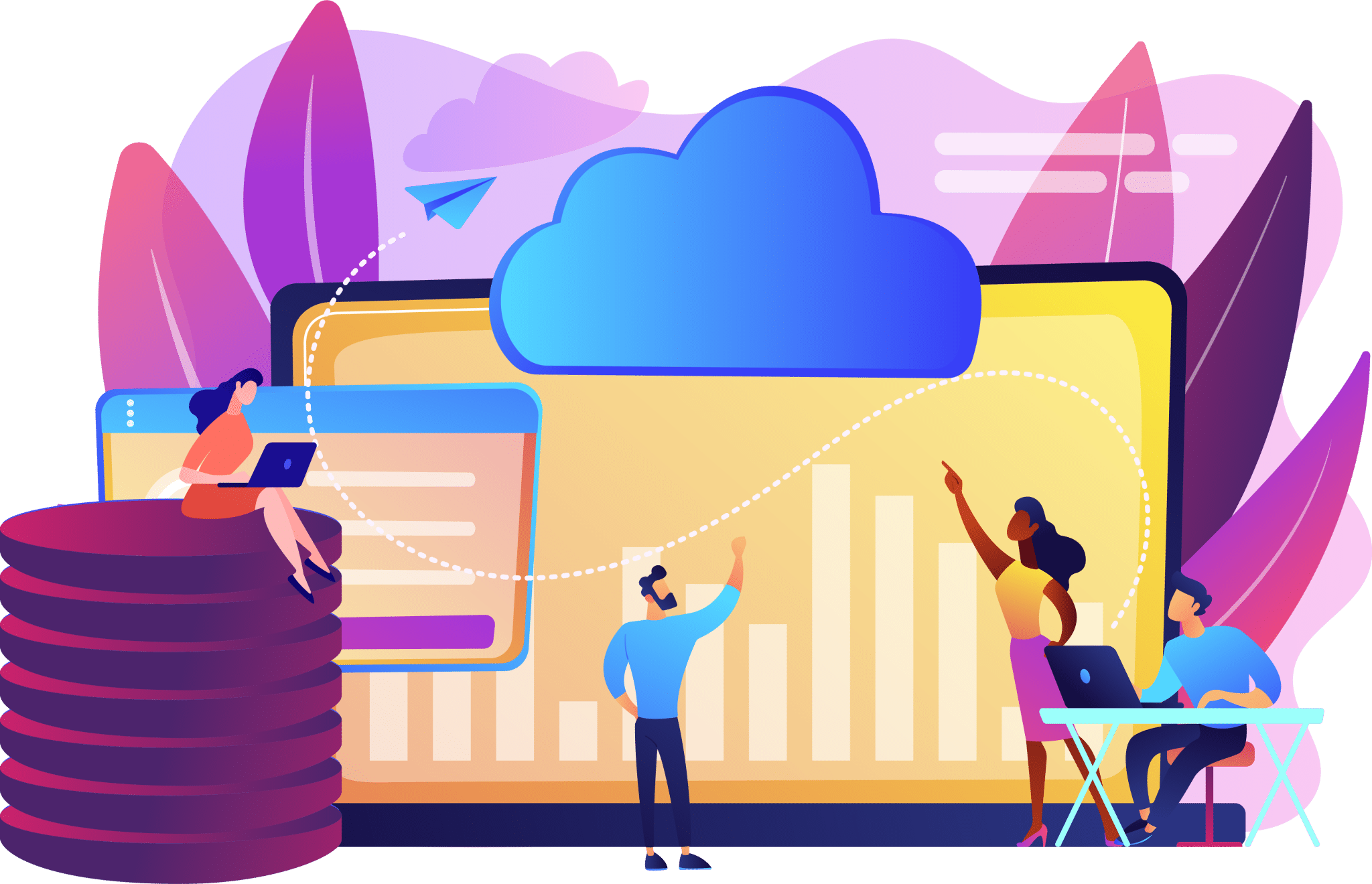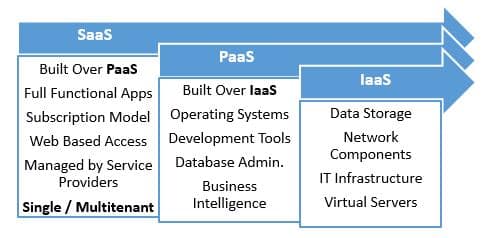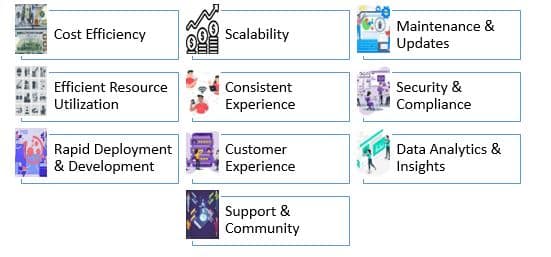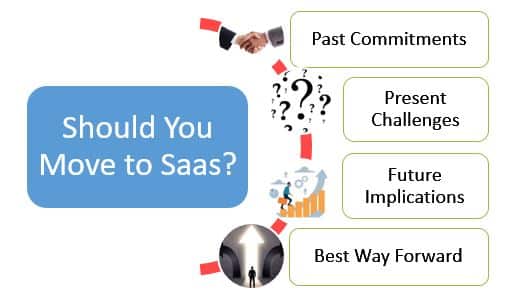Table of Contents
ToggleBefore proceeding with the debate of single tenant vs multi-tenant SaaS, let’s take a moment to discuss cloud computing services. Entrepreneurs and enterprises might be wondering about the scope and meaning of all the ‘aaS’ terminologies; let’s unravel that. Large data centers make it possible to store gazillions of bytes of data for businesses, nonprofits, institutes, or individuals. Just like email storage, you can buy storage or ‘cloud services’ from platforms for diverse services (as a Service). It lets you reduce costs, save time, and avoid the trouble of managing resources.
Cloud computing technologies are here for the better, be it a business industry or learning outcomes. The cloud computing market size worldwide in 2023 was around US$ 602.31 billion, according to the Grand View Research. It uses the internet for the distribution of IT services, including servers, data warehouses, infrastructure, software, analytics, and data security. With its four types of public, private, hybrid, and multi-clouds, it enables the delivery of the following types of cloud services.
Infrastructure as a Service (IaaS): Enables users to rent virtual machines, storage space, network components, and servers to manage their IT infrastructure virtually over the web.
Platforms as a Service (PaaS): Empowers users with an online platform to develop, execute, and manage apps, adding an operating system, development tools, database, and BI tools over IaaS.
Software as a Service (SaaS): Authorizes the use of software applications over the internet using a subscription model. Usually, you access applications through browsers without any installation.
We will discuss the SaaS model in more detail, leaving the IaaS vs PaaS vs SaaS debate. But rather than thinking about them as separate domains, consider the above image for reference. Besides these, numerous other cloud services exist that are beyond the scope of this blog, such as:
| Function as a Service (FaaS)
|
Enables code execution in response to events and user/data loads without managing servers. |
| Storage as a Service (STaaS) | Offers scalable storage solutions over the internet. |
| Database as a Service (DBaaS) | Provides managed database services to set up, operate, and scale databases. |
| Backup as a Service (BaaS) | Offers remote backup solutions, ensuring data recovery in case of data loss. |
| Disaster Recovery as a Service (DRaaS) | Assists disaster recovery, allows data recovery, and helps to resume operations after a disaster. |
| Communication as a Service (CaaS) | Distributes communication solutions such as voice over IP (VoIP), instant messaging, and video conferencing.
|
| Security as a Service (SECaaS) | Delivers security services such as authentication, anti-virus, anti-malware, and intrusion detection. |
| Artificial Intelligence as a Service (AIaaS) | Offers AI and machine learning tools and services to integrate with apps. |
| Internet of Things as a Service (IoTaaS) | Conveys platforms and services to manage and integrate IoT devices and data. |
| Blockchain as a Service (BaaS) | Provides a platform for developing, managing, and operating blockchain applications. |
| Containers as a Service (CaaS) | Enables app encapsulation into containers to deploy and manage in lightweight. |
What is SaaS?
Software as a Service, or simply SaaS, is a cloud computing service that grants access to fully functional software applications. Users can simply access these applications through their web browsers, regardless of their operating system or device category. It adopts a subscription-based pricing model, often only for signups, registration, or logging in with Google IDs. It eliminates the need to install apps and maintain them. However, many apps are still available for download.
SaaS software provides access to a wider user base by utilizing the scalable capabilities of serverless computing, adding an extra layer. It uses the underlying infrastructure and platforms from the IaaS and PaaS layers, respectively. The users don’t need to develop, manage, update, or optimize the applications, as service providers are responsible for that. However, it has two main types on the basis of how the app architecture manages users (tenants) that share a single app instance.
1. What is Single Tenancy SaaS?
The single tenancy SaaS or single tenant architecture allows each customer to have a separate instance on the app. Each tenant has a dedicated database where the software components and data are stored in isolation from others. Its users enjoy more control and freedom to customize app features or manage access controls by having an isolated instance.
2. What is Multi-Tenancy SaaS?
A multi-tenancy SaaS or multitenant architecture permits multiple customers to share the same instance of the app. The app partitions and isolates each tenant’s data to ensure discretion and security, managing different users simultaneously. It consumes the optimal resources by sharing them with all the tenants, including computation, storage space, and databases efficiently.
Single Tenant vs Multi-Tenant SaaS: Key Differences
Besides the instance isolation that defines the core categorization of a single tenant vs multi-tenant SaaS, there are many differences. It is essential to understand them to grasp the true essence of single-tenant vs multi-tenant SaaS and decide on the most suitable one. The following table depicts their key differences, while the subsequent headings elaborate them further.
| Aspect | Single-Tenant SaaS | Multi-Tenant SaaS |
| Instance Isolation | Each customer has its own instance of the app. | Multiple customers share the same instance. |
| Data Isolation | Each customer’s data is stored separately. | Data is securely partitioned and isolated. |
| Control & Customization | Customers have more control and customization options. | Customization options may be limited for shared features. |
| Resource Utilization | Each instance consumes dedicated resources. | Resources are shared among all tenants. |
| Scalability | Scalability may be limited by individual instances. | Scalability is easier due to shared resources. |
| Cost Efficiency | Potentially higher costs due to dedicated resources. | More cost-effective due to resource sharing. |
| Security | Enhanced isolation may provide better security. | Requires robust isolation mechanisms for data privacy. |
1. Data Isolation
Single Tenant SaaS
Each tenant has a dedicated database and instance, ensuring complete isolation of data. It can simplify compliance and enhance data security since data is physically separated.
Multi-Tenant SaaS
Data is logically separated within a collective database. Strong data partitioning techniques are used to prevent cross-tenant data access, but all tenants share the same software instance.
2. Customization
Single Tenant SaaS
Each tenant’s instance is extensively customizable to meet specific requirements without impacting other users. It allows custom configurations, unique features, and specific integrations.
Multi-Tenant SaaS
Customization options are more restricted because changes to the core application affect all tenants. Customizations are generally limited to settings and configurations that can be managed within the shared environment.
3. Performance
Single Tenant SaaS
Performance is isolated to each tenant, ensuring that one tenant’s usage does not impact another’s. Resources are dedicated, leading to predictable and consistent performance.
Multi-Tenant SaaS
The overall load on the shared system can influence performance. High usage by one tenant can potentially affect the performance experienced by others, although load balancing and resource allocation techniques can mitigate this.
4. Resource Sharing
Single Tenant SaaS
Each tenant has dedicated resources, resulting in higher resource utilization costs. There is no sharing of computing power, storage, or network resources between tenants.
Multi-Tenant SaaS
Resources are shared among multiple tenants, leading to more efficient use of infrastructure. This sharing can reduce overall costs and improve resource utilization.
5. Cost Efficiency
Single Tenant SaaS
Due to dedicated resources for each tenant, costs are generally higher. Maintenance, support, and infrastructure costs are not shared, leading to higher per-tenant expenses.
Multi-Tenant SaaS
Shared infrastructure and maintenance lead to reduced costs per tenant. Economies of scale allow the provider to spread costs across many tenants, resulting in lower prices for customers.
6. Scalability
Single Tenant SaaS
Scaling requires provisioning new instances and possibly additional infrastructure for each new tenant. It can be time-consuming and costly.
Multi-Tenant SaaS
Adding new tenants or scaling existing ones is straightforward, as the shared infrastructure can dynamically allocate resources. Its inherent scalability supports rapid growth and fluctuating demands.
7. Security
Single Tenant SaaS
With isolated environments, there is a reduced risk of cross-tenant data breaches. Security policies can be customized for each tenant, providing a higher level of protection.
Multi-Tenant SaaS
While strong security measures are implemented, logical separation requires robust mechanisms to prevent data leaks between tenants. Security needs to be managed carefully to ensure data integrity and privacy.
8. Maintenance and Upgrades
Single Tenant SaaS
Maintenance and upgrades can be scheduled individually for each tenant, providing flexibility but potentially increasing management complexity.
Multi-Tenant SaaS
Maintenance and upgrades are performed centrally, ensuring all tenants benefit from the latest features and security patches simultaneously. It reduces operational complexity but requires careful planning to minimize disruption.
Key Benefits of SaaS Multi-Tenant Architecture
The benefits of a Multitenant SaaS architecture are diverse and attractive to businesses aiming for exponential growth. It specifically outperforms other systems in terms of cost-effectiveness, scalability, and operational efficiency. Resource sharing among multiple tenants allows service providers to deliver high-quality experiences consistently. In addition, the huge upfront costs of building a platform get equally spread among consumers, with maximum resource utilization.
Moreover, central management and upkeeping allow for streamlining operations, enriching security, and ensuring compliance with regulatory obligations. SaaS solutions are becoming an inevitable part of today’s digital era, beneficial for providers and consumers alike. Let’s explore its benefits in detail to assess the feasibility and potential outcomes of initiating a multitenant SaaS project.
1. Cost Efficiency
Multi-tenant architectures share computing resources among multiple customers, which reduces overall infrastructure costs. The cost per user decreases as more customers are added since the same infrastructure supports multiple tenants.
2. Scalability
Adding new customers or increasing the capacity for existing ones is more straightforward, as the shared infrastructure can be dynamically adjusted to handle additional load. The responsive allocation of resources such as CPU, memory, and storage as per demand enhances scalability.
3. Maintenance and Updates
A single app instance is responsible for maintenance, updates, and patches, making it easier and faster to keep everyone up-to-date. Coordinated updates and centralized management minimize downtime, improving overall user experience by a significant proportion.
4. Efficient Resource Utilization
Sharing utilizes resources more efficiently, ensuring better performance and optimal allocation across all tenants. The architecture can automatically balance the load among the collective resources, leading to optimal performance even under varying workloads.
5. Consistent Experience
All tenants use the same version of the software, ensuring a consistent experience with adequate support and training. Rolling out new features and improvements uniformly to all users ensures that everyone benefits from the latest capabilities.
6. Security and Compliance
Security protocols, such as encryption, access control, and monitoring, can be centrally managed and applied, ensuring robust protection for all tenants. Compliance with regulatory standards like GDPR and HIPAA can be implemented centrally, warranting that all tenants abide by the same compliance measures.
7. Rapid Development and Deployment
Developers maintain a single codebase for the application, simplifying development and reducing the potential for bugs and inconsistencies. Streamlining the development process allows for quicker iteration and faster deployment of new features and improvements.
8. Customer Experience
Infrastructure sharing lowers the cost of entry for customers, making high-quality software accessible for small businesses within their budgets. Service providers usually offer more flexible and competitive pricing models like diverse subscriptions to accommodate different client needs.
9. Data Analytics and Insights
Collecting and analyzing data from all tenants centrally provides valuable insights into usage patterns, performance metrics, and customer behavior. Data aggregation helps managers make data-driven decisions on feature enhancements, resource allocation, and customer support.
10. Support and Community
Centralizing support on a single instance makes it easier to address issues and assist customers. A larger user base can foster a more vibrant community, enabling users to share experiences, solutions, and best practices.
Should You Move from On-Premise to SaaS?
Choosing between SaaS vs hosted software vs on-premises is a strategic choice, posing various challenges and concerns. The concerns may arise from past decisions that demand commitment, present challenges that need resolution, and future implications requiring planning. As its many benefits portray, SaaS multitenant architecture is ideal for medium to large enterprises for their business growth. However, to gain a clear picture with regard to industry leadership, we address the past, present, and future concerns subsequently.
1. Past Commitments
More often than not, our past decisions impact our ability to choose among a few available alternatives. Past investments, contracts with external partners, and existing infrastructure make it difficult for businesses to move to SaaS. Moreover, significant investments in on-premise IT infrastructure may pose cost-sinking risks in addition to compromising software customization. Analyzing all of these past commitments proposes various what-if scenarios, averting businesses.
2. Present Challenges
Firms seeking rapid growth and technical support need ongoing maintenance and upgrades, such as hiring expensive technical resources or outsourcing. Scaling up on-premise infrastructure is more expensive, let alone complex, and becomes challenging with seasonal fluctuations. Moreover, it is a paramount concern to ensure data security and compliance. SaaS solutions offer scalability, allowing for the handling of demand variations, along with reliable security features and compliance.
3. Future Implications
Organizational goals require system upgrades and modernizations in accordance with emerging technologies and shifting customer demands or preferences. In this case, agility and innovation become a prime concern for firms where on-premise systems and SaaS solutions are a bit heavy. Cost considerations and remote work practices further demand a hybrid model, raising costs again. Businesses might need to move to the cloud but delay it in hopes of an alternate way.
4. Best Way Forward
In view of the above parameters, what if we tell you there’s one best solution? If you are willing to invest in your growth and aim for industry leadership, a custom multitenant SaaS is perfect. It hybridizes the benefits of SaaS multitenant architecture, custom software, and strategic alliance. Not only do you become partners with your industry peers, but you also pool your resources to deliver better customer experiences. Truly, large enterprises collaborate for market leadership.
Use Cases of Custom Multi-Tenant SaaS
There are dozens of case studies and success stories of custom multitenant SaaS solutions in the market. From healthcare and fintech to transportation and social media, numerous industries benefit from industry-wide collaboration and resource pooling. We will refer to the following three success cases that are a valuable part of Unique Software Development’s portfolio.
1. Traver Connect
Traver Connect inaugurates its all-inclusive multi-tenant CMS, CRM, and Telecom solution for automotive dealerships and their clients. The system not only simplifies vehicle maintenance, appointment bookings, and customer relationship management but also converts BDC leads into sales. It uses the latest tech stack, including ASP .NET Core 3.1, SQL Server, Redux, MS Azure, React JS, and CosmosDB. The solution uplifts its member dealerships’ lead conversion strategies with user training, software support, and a business development center (BDC).
2. Cascade Fintech
Cascade Fintech is a revolutionary prepaid and debit card issuance service, enabling swift market entry for clients from any niche. The solution simplifies and optimizes card issuing processing as a trustworthy program manager for other companies seeking financial product launches. Its solution stack includes Kotlin, Swift, .Net, .Net Core, and TAS (by TAS Group) and cloud-based data warehousing. The solution offers a wide range of multitenant fintech products and services to fuel business success in diverse industries.
3. Yours Might Be Next
With numerous success stories on its portfolio, Unique Software Development specializes in custom software development and SaaS multitenant architecture. Regardless of your industry, our expert solution architects can formulate your custom SaaS multitenant architecture to grow beyond traditional means. Your solution might be just a call or email away, awaiting your action to become your industry’s most indispensable asset. How? Contact our representatives today!
Conclusion
It is just the beginning of the single-tenant vs multi-tenant debate, and it will gain more traction in the coming years. By far, we can only analyze the benefits and limitations of both alternatives unless sufficient data is available. By then, we need to evaluate and dig deeper into what SaaS is, what single tenancy is, and what multi-tenancy is. This blog addresses the single-tenant vs multi-tenant SaaS debate to highlight their key differences and, specifically, the benefits of the latter. It sheds light on why you should move from on-premise to SaaS and what it offers via use cases.


















